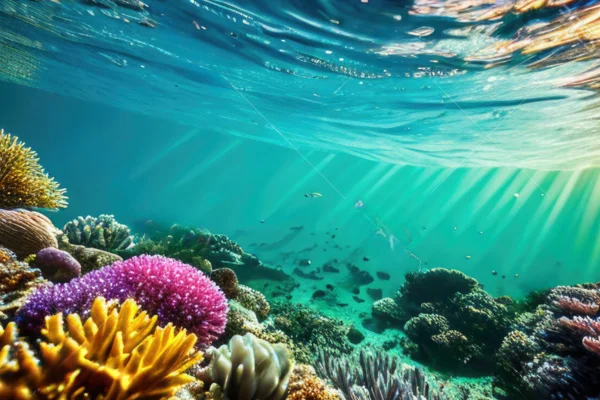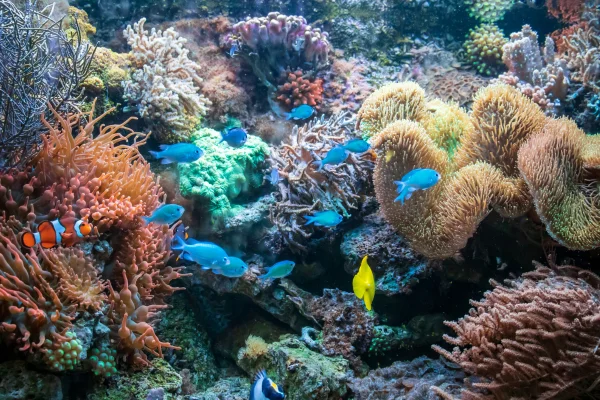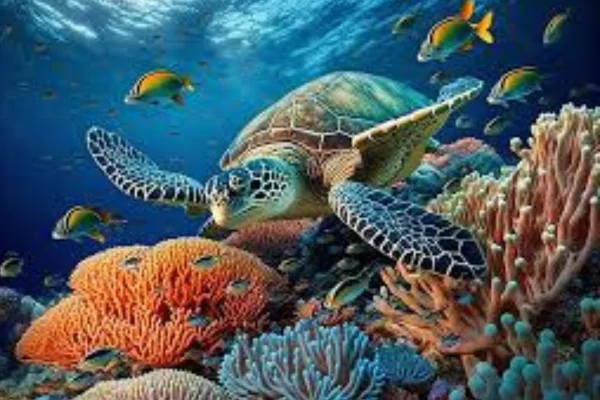The Colorful Life of Coral Reefs
Coral reefs are true treasures of the ocean, forming some of the most diverse and vibrant ecosystems on the planet. The dazzling beauty of corals, with their exuberant colors and intricate shapes, hides a complex world of ecological interactions and evolutionary adaptations that enchant scientists and laypeople alike. Let's dive into this underwater universe to explore the wealth of life that flourishes in coral reefs and understand why these ecosystems are so important to our planet.
What Are Coral Reefs?
Coral reefs are underwater structures formed mainly by scleractinian corals, also known as stony corals. These corals build skeletons of calcium carbonate, which accumulate over thousands of years, creating the vast formations we see today. There are three main types of reef: fringing reefs, which form along the coast; barrier reefs, which are separated from the coast by a lagoon; and atolls, which are ring-shaped reefs that surround a central lagoon.
Contents

The Magic of Colors
The first thing that strikes you when looking at a coral reef is the explosion of colors. These vibrant colors are the result of a symbiotic relationship between corals and microalgae called zooxanthellae. The zooxanthellae live inside the coral tissues and carry out photosynthesis, providing essential nutrients for the corals. In return, the corals provide the zooxanthellae with a protected environment and access to sunlight. Colors vary according to the species of coral and the density of zooxanthellae, creating a kaleidoscope of shades ranging from blue to purple, yellow, orange and red.
Exuberant Biodiversity
Coral reefs are home to an impressive biodiversity. Although they occupy less than 1% of the ocean's area, they are home to around 25% of all known marine species. Reef dwellers include fish, molluscs, crustaceans, sponges, anemones, sea urchins and many other forms of life. Each species plays a vital role in maintaining the ecological balance of the reefs.
Reef fish
Reef fish are perhaps the best known reef dwellers. Species such as the clownfish, famous for the film "Finding Nemo", and the parrotfish, with its vibrant colors and strong beaks, are examples of the incredible diversity of fish that inhabit these ecosystems. Reef fish play essential roles, such as controlling the population of algae that can suffocate corals and serving as food for larger predators.
Invertebrates
Invertebrates such as crustaceans and molluscs are also abundant on coral reefs. Shrimps, crabs and lobsters hide in the crevices of the corals, while octopuses and squid glide gracefully through the waters. These animals not only contribute to biodiversity, but are also important for local fisheries, providing livelihoods for millions of people around the world.

Ecological and Economic Importance
Coral reefs are not only beautiful and biodiverse, they also perform crucial ecological and economic functions. They act as natural barriers, protecting coastlines from erosion and the impacts of storms. In addition, they are valuable sources of resources for fishing and tourism. It is estimated that more than 500 million people depend directly or indirectly on coral reefs for their livelihoods.
Tourism
Tourism is one of the main sources of income associated with coral reefs. Millions of tourists visit diving and snorkeling destinations every year to enjoy the underwater beauty of the reefs. Places like the Great Barrier Reef in Australia and the Caribbean reefs are famous for their crystal clear waters and abundant marine life. This tourism generates billions of dollars in revenue and sustains local economies.
Fishing
Coral reef fishing is another vital economic activity. Many of the fish and invertebrates that inhabit reefs are important sources of food for coastal communities. Sustainable fishing is crucial to ensure that these resources remain available for future generations. Unfortunately, overfishing and destructive fishing, such as the use of dynamite, threaten the health of reefs and the biodiversity they support.
Threats to Coral Reefs
Despite their importance, coral reefs face numerous threats. Climate change, pollution, ocean acidification and destructive fishing are just some of the pressures that put these delicate ecosystems at risk.
Global Warming
Global warming is one of the biggest threats to coral reefs. Rising sea temperatures cause coral bleaching, a phenomenon in which corals lose their zooxanthellae and, consequently, their vibrant color. Without zooxanthellae, corals lose their main source of nutrients and can die if conditions don't improve quickly.
Pollution
Pollution, from both land and sea sources, is another major threat. Chemicals, sewage, plastic and sediment from agriculture and construction can suffocate corals and block the sunlight needed for zooxanthellae to photosynthesize. Pollution also encourages the growth of harmful algae that compete with corals for space and resources.
Ocean acidification
The acidification of the oceans, resulting from increased concentrations of carbon dioxide in the atmosphere, reduces the ability of corals to form their calcium carbonate skeletons. This weakens reef structures, making them more susceptible to damage and erosion.
Conservation and Hope
Despite the challenges, there is hope for coral reef conservation. Conservation initiatives, such as creating marine protected areas, restoring reefs and promoting sustainable fishing practices, are gaining momentum around the world. Scientists are also exploring innovative methods, such as corallivage, to grow and transplant corals that are resistant to bleaching.
Conclusion
The colorful life of coral reefs is testimony to the incredible biodiversity and complexity of marine ecosystems. Protecting these underwater treasures is essential not only for the preservation of marine life, but also for human well-being. Through conservation and awareness-raising efforts, we can ensure that future generations can continue to marvel at the beauty and diversity of coral reefs.
Thanks for stopping by, check out our other work too
https://vettopbr.com/tosse-em-caes/








